The region has entered its 30th year of discussion about funding Metro.
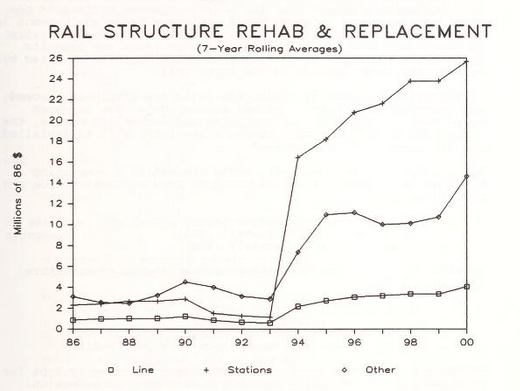
Projected rail structure maintenance costs from the 1986 FCC study.
There has been a lot of talk recently and even more sound bites about the need for more consistent, reliable, and dedicated funding for Metro. But while it may seem like an innovative topic, discussions about Metro’s funding challenges and the need for a dedicated funding stream for Metro have been going on for … decades. This has been an identified problem and heavily-studied topic since at least 1986 – the year the Oprah Winfrey Show debuted, Top Gun was the highest grossing film, and Ferris Bueller took a day off.
Truth be told, scores of very smart people have expended time and effort and resources to articulate the problems, accurately predict the consequences of inaction, and suggest solutions suitable (and necessary) for implementation. So when you read “news” about Metro’s funding challenges, the problems it creates, and potential fixes – remember that what you are reading is hardly “new”. And no refrain is older than the “it’s not the right time”, to which we must remind the reader that for three decades, it hasn’t been “the right time”. How’s that working out, anyway?
Below are a few of the studies and reports generated on Metro’s funding challenges and possible solutions to closing the funding gap:
- In 1986, while we were still building the Orange Line to Vienna, the Federal City Council completed a study that raised concerns about long-term maintenance costs of Metro, the impacts on the jurisdictions, and the tradeoffs between building out the Adopted Regional System and investing in maintenance. (WAMU’s Metropocalypse’s Podcast, Episode 5 provides a short summary on the importance of 1986 and this report, starting at 8:20.)
- In 2004, the year Metro Matters (pdf), a $3.3B funding agreement to address capital needs, was approved, the Brookings Institution authored Deficits by Design, which called attention to the annual funding crises brought about by its “problematic revenue base.”
- In 2005, the Metropolitan Washington Council of Governments, Federal City Council, and Greater Washington Board of Trade published the findings of the Metro Funding Panel, which recommended a Compact-wide increase in the sales tax of one half of one percent (0.50%).
- The Great Society Subway, published in 2006, outlines how Metro came to be and specifically speaks to the financial elements in Chapter 7. (Its author, Zachary Schrag, was interviewed in the Washingtonian in April 2016 and touches on dedicated funding as well.)
- In 2006, Metro’s 30th anniversary, the federal government followed the trend and commissioned a study by the General Accountability Office to understand the issues with providing a dedicated funding sources locally.
- In 2016, Metro’s 40th anniversary, the Metropolitan Washington Council of Governments (COG) and the Greater Washington Board of Trade (BOT) convene a set of meetings (“summits”) to discuss the future of Metro with a major focus on governance and funding.
Studying – check. So now what? Read more…
In its efforts to make Metro safer and more reliable, Metro puts the customer first.
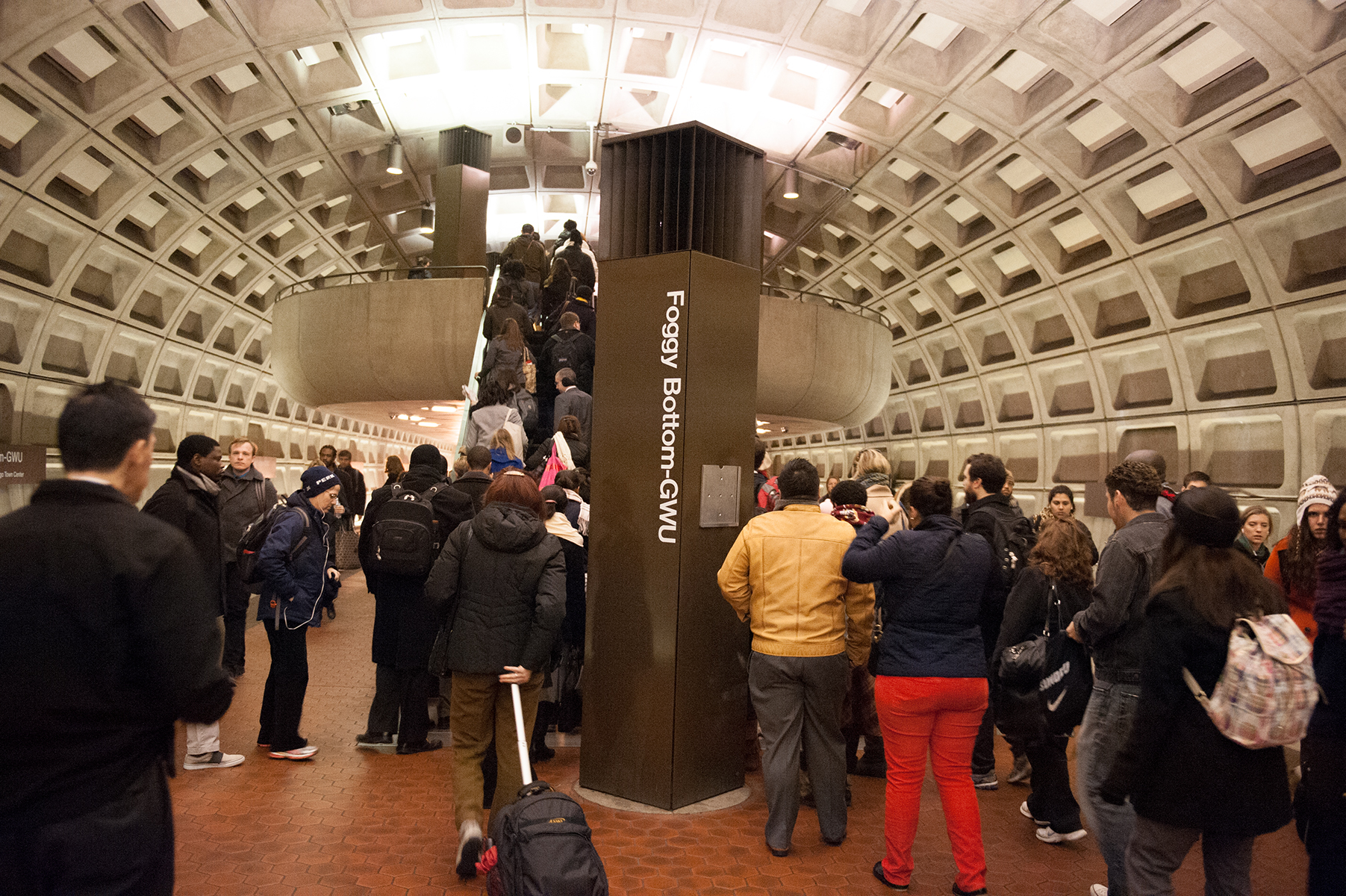
Addressing capacity constraints in our stations, such as Foggy Bottom shown here will provide a safer and more reliable trip for Metro customers. Image source: WMATA.
The last year, implementation of Momentum, the WMATA strategic plan, was paused to permit a laser focus on all things safety and reliability. Safety and reliability are what our customers deserve and what they are asking for. Here’s how we pledge to address these critical issues at Metro within the context of putting customers first.
Engage our customers. And listen. Metro’s new General Manager and CEO, Paul J. Wiedefeld has dedicated a great deal of time since he came aboard talking with and listening to his constituents. He did this because he knows that to get their support he has to listen to their concerns and ideas for our system and services. Metro has the tools in place to regularly engage their customers, starting with the American Planning Association-award-winning Public Participation Plan (PDF) but also including a newly formed customer community, Amplify, available for online conversation on a wide variety of topics and initiatives. Let’s follow the lead of the new GM and engage our customers in dialogue on addressing today’s problems as well as rebuilding Metro for the future.
Read more…
February 24th, 2016
Shyam
The Federal Government is the region’s single largest employer, and where it chooses to locate its jobs has huge implications for ridership, revenue, and the local operating subsidy.
We recently detailed why the Federal government’s location decisions matter so much to Metro – and you, the taxpayers who help support WMATA through your local taxes. We’re always keeping an eye on moves within the region and certainly hopeful that any major moves (whether they are in the public sector or private sector) locate near Metrorail. That’s because locating near Metrorail increases ridership, increases farebox revenue, and lowers the (your) taxpayer burden to support Metro.
Naturally, the news about GSA’s upcoming decision on the location of the US Citizenship and Immigration Services complex (USCIS) caught our eye and wonkiness. We wanted to know about how much ridership and revenue the different options might generate.

Read more…
As Metro kicks off its public engagement effort for next year’s capital and operating budgets, now is the perfect time to get involved in helping shape the Authority’s priorities for the next few years!

This is the second of three related posts that attempt to de-mystify transit funding and give the residents of Metro’s service area some tools to engage in budget discussions. The first post focused on the Capital Funding Agreement (CFA, PDF) and the Capital Improvement Program (CIP, PDF), which together establish a six-year framework for funding projects that improve the Metro System’s safety, reliability, and performance. This post focuses on how the CIP translates into an annual capital budget, and the next post will explore the annual operating budget.
Read more…
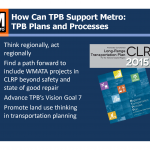
Metro and the Transportation Planning Board (TPB) engaged in a wide ranging discussion with TPB board members about how the TPB and the region’s jurisdictions can support Metro now and in the future. Not surprisingly, there’s a lot more to it than just predictable funding.
At the December 16th Transportation Planning Board (TPB) meeting (audio), Metro Board Member Harriet Tregoning gave the final presentation (pdf) and facilitated a discussion on Metro’s challenges and provided specific recommendations and/or opportunities for the TPB and local jurisdictions to increase their support the Authority today, tomorrow, and into the future. The focus of the discussion was specifically on plans, processes, and actions that the TPB and local jurisdictions can modify or begin that will ensure predictable funding and/or enhanced funding options, incorporate land use as a transportation strategy, increase transit-supportive land use decisions, prioritize bike and pedestrian access, and advance bus priority on the streets that local jurisdictions operate.
Last summer, TPB members requested a more extensive conversation surrounding Metro’s challenges as well as recommendations on how TPB, through its plans and processes, and local jurisdictions, through their decisions and funding, could support Metro. Metro opted to provide three presentations and the December presentation built on information provided at the November 18th meeting (audio) on Metro Fundamentals (pdf) and Momentum (pdf) that were given by Tom Webster, Managing Director of Metro’s Office of Management and Budget, and Shyam Kannan, Managing Director of Metro’s Office of Planning. The November presentations served to ensure a baseline understanding across TPB Board members, highlight our capital and operating challenges, and identify safety, state of good repair, and longer term needs to ensure safe, reliable transit that meets the growing region. Read more…
Categories: Engage Tags: BRT, bus, funding, local jurisdictions, meetings, Metro 2025, Metrobus, Metrorail, Momentum, planning, presentations, support Metro, tod, TPB, transit-oriented development, Transportation Planning Board, walkability
One of the most critical issues facing public transportation is how to pay for it. In a short series of blog posts, we’ll try to explain Metro’s finances and give you tools to engage in budget discussions.
No matter where you stand on the question of supporting or using public transportation, one of the loudest and most constant debates is how to pay for it. It’s a complicated question that combines values, politics, resources, and legal obligations. It also revolves around the technicalities of multiple funding sources (fares, grants, taxes) and how those sources can be spent (allowable types of projects, legal requirements, matching funds, etc.). Most people probably know Metro operates under a yearly budget. However, that annual budget and Metro’s ability to raise and spend funds is shaped by a larger policy and planning framework. This initial post focuses on three pillars of that policy framework: the WMATA Compact, the Capital Funding Agreement (CFA), and the six-year Capital Improvement Program (CIP). It also summarizes the annual budget planning process.
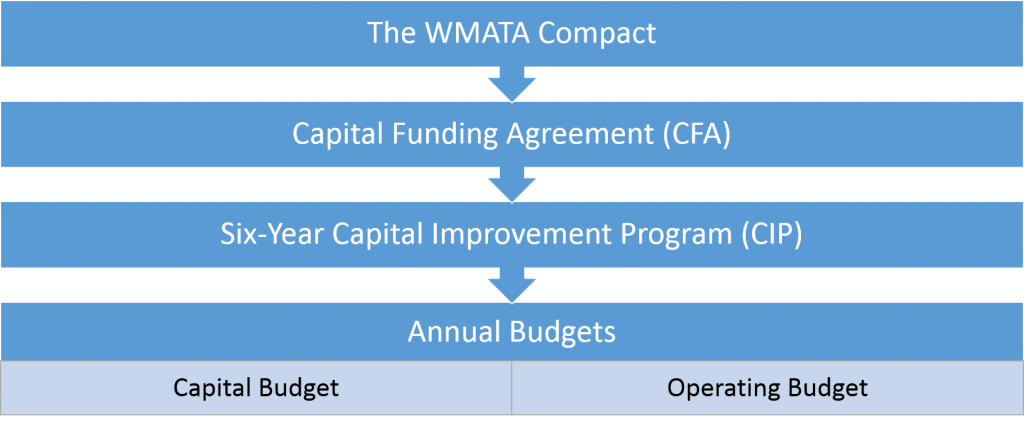
WMATA’s funding policy framework
Read more…
Secretary Foxx has issued his direction that Metro cannot consider any new rail expansion right now, and WMATA agrees! So much so that we wrote it into our strategic plan back in 2013. Earlier this fall, the Prince William County’s Board of Supervisors heard from WMATA about the importance of fixing Metro’s core before considering any expansion.

The Silver Line’s Phase 2 extension from Wiehle-Reston East to Dulles Airport and Loudoun County could be the last for decades to come. (photo credit: Ryan Stavely, Flickr)
As the region grows, so does the pressure for extensions of Metrorail. The requests are frequent and common: “Extend Metro to BWI! to Centreville! to Waldorf! to Fort Belvoir!” We’ve heard and even modeled most of these requests. For a system that’s shaped and contributed tremendous economic value to the region, it only makes sense that communities outside of its immediate reach want improved access to it. WMATA Director of Planning Shyam Kannan recently took the opportunity to discuss the potential for the extension of Metrorail into Prince William County. With 80% of today’s Metrorail trips going to or through the system’s core (PDF), he noted that major core capacity improvements must be made prior to considering any additional rail extensions. While addressing core capacity has been a major part of Momentum, including initiatives like the 8-car train program, core stations, and New Blue Line Connections, the plan remains largely unfunded. With safety and state of good repair needs as Metro’s top priorities and core capacity relief put off indefinitely, any potential extensions (if they happen) are likely decades away from being built.
Read more…
Categories: Strategies Tags: BRT, commuter rail, core capacity, corridors, expansion, land use, LRT, Metro 2025, Metrorail, Momentum, policy, Streetcar, tod, transit-oriented development
September 11th, 2015
Mark
Metro is exploring opportunities to partner with a private company or investor to pilot off-board SmarTrip® loading to help improve customer travel times and lower our operating costs.
Metrobus speeds have steadily decreased over time as the region grew and traffic worsened. This not only negatively impacts Metro customers, but also increases our operating costs. As traffic congestion erodes bus speeds, we need to deploy more vehicles and operators on the busiest routes in order to maintain service frequencies. We know that behind the statistics stand legions of bus riders who want faster service, as well as counties and cities that want lower bills for that service.
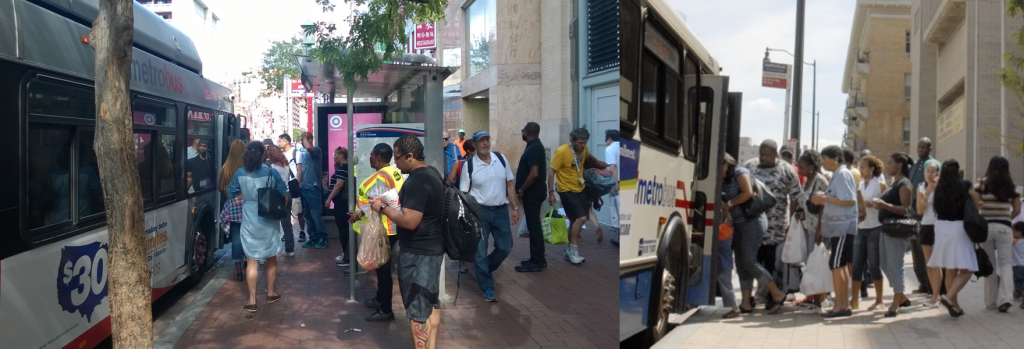
Crowded boarding and long dwell times
Off-Board Fare Payment and Transit Prioritization
There is no silver bullet to speed up transit. Instead, agencies can use a combination of technology and on-street treatments to increase bus speeds and move more passengers. One of the few prioritization strategies Metro can undertake on its own is allowing off-board fare loading, moving all SmarTrip® value loading from the farebox to kiosks near bus stops. This would reduce the amount of time it takes for passengers to board buses and pay fares, in turn speeding up bus trips. We have looked into this in the past and have recently revisited this important concept. Read more…
Where and when does Metrorail generate the most farebox revenue? So far the data reinforces the notion that ours is a truly regional system with strong revenue contributions from all jurisdictions – but of course, the story is far more complicated than that…
What kind of rail system is Metrorail? Urban subway? Commuter rail? Hybrid? The answer of course is all of the above. And if that is the case, what kind of ridership and revenue patterns should its stations and system exhibit? High levels of peak revenues with heavy commuter lot usage but relative inactivity during the day? Lower levels of peak period activity but a steady stream of usage throughout the day? Depending on your perspective (and travel patterns) one might argue for either, and it might seem easy to apply a blanket classification to Metrorail and declare that “only urban stations cover their cost” or “commuter stations contribute largely to Metrorail’s revenue picture.”
Well, when you throw the data up on a map, it becomes clear that there are no easy answers, and no one right way to view the revenue picture of our tri-jurisdictional hybrid rail network. Some conclusions from the data are intuitive, some less so. Among them:
- Differences in ridership across stations are bigger than differences in revenue, so ridership is a stronger explanation of differences in revenue than fares. For example, Shady Grove’s average fare in the AM Peak is $5, which is twice as much as the smallest average fare. On the other hand, ridership at Shady Grove is ten times higher than other stations, so the ridership better explains the station’s revenue.
- In the AM Peak, the terminal stations dominate in terms of revenue contribution. Union Station functions as an internal “terminal station,” meaning that the commuter rail and Amtrak connections to Metro are extremely important to the overall ridership and revenue picture.
- Other stations with strong bus or commuter park-and-ride infrastructures also pop in the AM Peak, such as Silver Spring and Grosvenor.
- Note how well the non-Silver line stations in Virginia perform in the AM Peak, as well as the somewhat expected better performance of the Shady Grove branch of the Red Line in the AM Peak.
- In the PM Peak, the core is king. Stations like Farragut West and North, Metro Center, L’Enfant Plaza are producing $50,000 apiece every evening thanks to their job densities, reinforcing the importance of improving their capacity for the future in Metro 2025, as well as their huge importance to revenue today. By comparison, in the AM Peak, only Shady Grove and Vienna approach these levels of revenue at roughly $40,000 per station.
- The New Carrollton and Largo Town Center branches of the Blue/Orange/Silver Lines contribute significantly less revenue than other branches, and this directly relates to the relative lack of transit-oriented development along these spines. The station areas on these lines enjoy a superb level of rail connectivity to the region’s primary job cores, but without sound transit-oriented investments to-date, they have not yielded the type of ridership and revenue commensurate with the capital investment. Imagine what Metro’s revenues (and farebox recovery) could look like if these segments were properly developed!
We’ve been examining the data ourselves as we continue forward with Momentum’s call for us to ensure financial stability for the Authority and have created the visualization for you to play with. We’d love to know what you see!
A large majority of trips on Metrorail cross jurisdictional boundaries, illustrating that Metro is indeed a regional service.
We’ve mentioned before how the station improvements in Metro 2025 will benefit riders from all jurisdictions. In fact, Dupont Circle is the only station identified in Metro 2025 with a majority of users living in DC. We thought we’d take another look at ridership that crosses jurisdictional boundaries. The table below illustrates the percent of trips, by jurisdiction of origin, that cross into another jurisdiction on Metrorail, sliced by Weekday AM Peak, Weekday PM Peak and Weekend. Data is from October 2014 and includes the new Silver Line stations.

A few things pop out: Read more…










Recent Comments